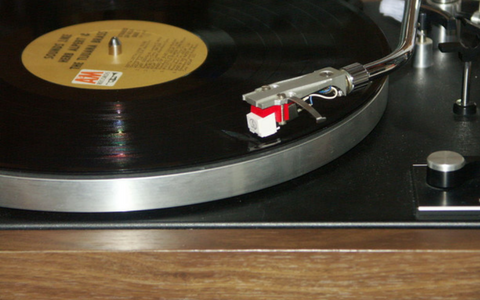Let The Moon Cleanse Your Record - The Ultimate Guide to Vinyl Cleaning
"...it looked as if she kept it in an ashtray full of hungry beavers."

Published
I didn’t think I would ever be one of those people; the pretentious “Vinyl Kids.” You know, the ones who get into arguments on reddit about “compressed digital audio” and “tracking weight,” all while slipping their records into sleek polypropylene sleeves and never playing them because “they might get dirty” and “just having them is enough…”
That is, until I found a rare copy of 2814 - Birth of a New Day on vinyl. It was 60 dollars, and while most other copies sold for 130 or more, I had to buy it. I can now say it was totally worth it. I didn’t open it for about a week because I didn’t have any record sleeves to protect it. But when they arrived, I cracked the clear plastic seal open, dropped the needle, and I got it. I understood the hype. There was something about seeing a large disk slowly spinning that draws you in and enhances the experience. It gives you a feeling that you’re part of something large, something grand, something that the universe wan-
“SQUEAAK.”
I jump out of the chair. That was definitely not part of the song. I run over to the record, pop up the arm, and turn the motor off. That’s when I see it:
A giant pink thread right on the border of tracks 2 and 3.
How did that get there? I definitely don’t have any pink shirts with me in my apartment, and there’s no pink rugs or furniture. In fact, now that I am taking a closer look at the record, there is dust everywhere on this thing. It was acting like a magnet, picking up slightly-charged particles in the air until they accumulated into little mounds between the grooves. It was both fascinating and frustrating, and I wanted a solution. So, I went to the internet.
Last April, a few friends and I made our way into an abandoned 80’s nightclub in East Cleveland. We found a dead raccoon, a petrified pile of pickles, bottles upon bottles of hot sauce, and over 100 LPs of nightclub disco sitting in a bright blue tub (you can watch it as it unfolded here). After getting yelled at and threatened by the neighbors, the records were ours.
What we did not take into account was that most of them were extremely dirty and unplayable. At least half of them took on a light gray color due to the dust and water damage. But after some AJAX and scrubbing, they were at the very least listenable, and I was satisfied.
All of this has gotten me thinking about cleaning records. I’ve seen many different ways online, ranging from using a cotton shirt, to the wood glue method, to playing them underwater. So I decided to test these methods out, and toss my findings into the black void of the internet.
THE CANDIDATE
I don’t know why my sister owns a copy of No Fixed Address by Nickelback on vinyl. I’m not sure if I would like to know. But she did, and it looked as if she kept it in an ashtray full of hungry beavers. She claimed it was a “gag gift” and she received it used, so I gladly took it off her hands. I took the record out of the crispy paper sleeve, tossed it on the deck, and dropped the needle. The slow drone of Million Miles An Hour slowly filled the room.
“I can taste the color of-color of-color of-color of-”
I was four seconds into the first song and it was already skipping. This was perfect. I went to Home Depot that night to gather supplies, and commenced testing the next day.
THE WATER SCRUB
The first thing I did was soak the record in 140 degree water for about an hour. I didn’t really care about the center label, so keep in mind that water will definitely deteriorate it. When I came back to take it out, the water was noticeably darker, so I knew that something was working. I grabbed an old cotton shirt that I used for grade-school basketball, cut it up into a large square, and began wiping the record in a circular motion along the grooves. I continued doing this until the record was completely dry. Then I switched to a new piece of the shirt and did the same thing for about half as long.
Upon playing the record, I was able to get through the first three songs without a single skip.
The white shirt pieces had turned black, so it definitely removed a lot of the dirt. But there were still loud hisses and pops every second or so. I decided to move on to the next test.
WOOD GLUE
I removed much of the surface dirt, but there was still a lot of gunk down in the groves. I hit the record with a hair dryer on the “Cool” setting (do NOT use hot!) for ten minutes, making sure it was completely dry. Then I began spreading wood glue around the grooves. I took a sponge brush and painted a quarter-inch of glue around the entire record, then immediately put it under a fan on “low” setting. I was worried that it would drip off the side of the record, but it stayed put thanks to its viscosity. After three hours, the glue was dry. I very carefully started to bend the record until the edge of the glue lifted from the surface. I was the able to slowly peel back the glue off of the record. It had a lot of dirt stuck to the bottom, and the grooves looked much cleaner. I wiped the surface with a solution of windex and water, and put it back on the deck.
This time, I was able to get through the first side without a skip, and there weren’t as many pops or hisses. But something was still off about the sound. It seemed distorted and it made it difficult to continue listening. I decided to move on to my favorite test of all.
THE HYDROPLANER
For this test, all you need to do is coat the entire record in a very fine layer of water, and play it that way. I know, it’s crazy, but it works, This will eliminate most of the snap-crackle-pops, and at 33 RPM the centripetal acceleration will not be enough to fling water everywhere. Try not to make the water too deep though, as this can damage the needle over time.
After spending hours performing these tests, the chewed-up record started to sound listenable again. Most of the scratches and skips were unnoticeable, and it returned to its normal black color. It’s amazing to think that I spent only about ten dollars to get this back into the shape it once was some time ago.
But something still wasn’t right. It just sounded so distorted, so wrong. It’s like every fibre in my being was telling me to turn it off and throw it out a window. So, I decided to compare it to the original on spotify. I turned a couple dials on my stereo receiver and hit play. And that’s when I realized my fatal mistake.
This was Nickelback. Why would it ever sound good? I just spent 5 hours of my life that I will never get back trying to restore something that my mind deeply hates, and for what? Science? Saving other people time by spreading awareness of cleaning methods for a 60-year-old auditory medium? No. I turned off the record player, grabbed my coat, and went for an existential walk.
I think I’ll just stick to Spotify. For now at least.
Stephen Schrimpf is host to The Node Show with DJ Crystal Lakes on AROUSE Wednesdays from 9p-10p.

